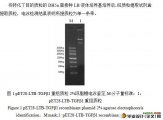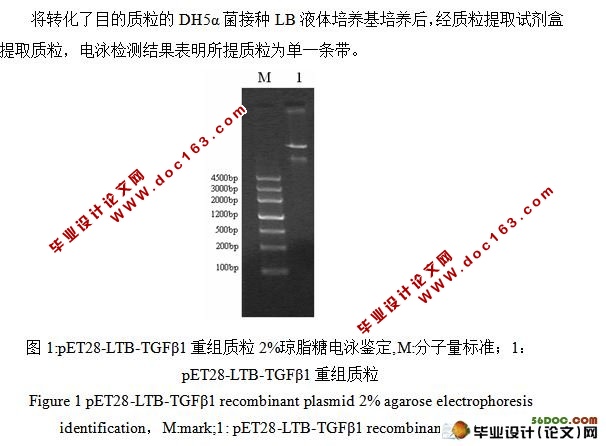通用辅助T细胞表位转化生长因子融合蛋白原核表达质粒构建

通用辅助T细胞表位(PADRE)-转化生长因子β1( TGFβ1)融合蛋白原核表达质粒的构建(7000字)
摘 要:转化生长因子( TGFβ1)是一种强烈的免疫抑制因子,近年来还发现其可诱导调节性T细胞的生成而介导特异性免疫耐受,在家畜的持续性感染过程中发挥重要的作用,抑制TGFβ1作用可在家畜持续性感染过程中免疫系统完成对本实验采用原核表达转化生长因子β1与PADRE融合蛋白质的质粒构建。在通过转化生长因子β1( TGFβ1)融合蛋白原核表达及纯化,来诱导机体产生抗自身TGFβ1的抗体。方法:通过原核表达质粒的构建对通用辅助T细胞表位进行分析。结果:通过原核表达观察通用辅助T细胞表位(PADRE)-转化生长因子β1( TGFβ1)融合蛋白的一些性质。
关键词:通用辅助T细胞表位, 转化生长因子β1,原核表达
CONSTRUCTION OF PADRE -TGFβ1 FUSION PROTEIN PROKARYOTIC EXPRESSION PLASMID
Abstract :Transforming growth factor (TGFβ1) is a strong immunosuppressive factor, In recent years also found that regulatory T cells can induce the formation of the induced specific immune tolerance, persistent infection in domestic animals play an important role in the process, the role of inhibition of TGFβ1 persistent infection in domestic animals in the immune system to complete the process of the present study, prokaryotic expression of transforming growth factor β1 and PADRE fusion protein plasmid. Through transforming growth factor β1 (TGFβ1) fusion protein expression and purification, to induce antibodies against self TGFβ1. Methods: Prokaryotic expression vector of the general secondary T cell epitope analysis. Results: The expression of the original observation common auxiliary T cell epitope (PADRE) - transforming growth factor β1 (TGFβ1) Some properties of the fusion protein.
[来源:http://www.doc163.com]
Keywords:General secondary T cell epitope,Transforming growth factor β1,Prokaryotic expression
[来源:http://www.doc163.com]

目 录
摘要……………………………………………………………………………1
关键词…………………………………………………………………………1
1前言……………………………………………………………………………2
1.1转化生长因子β1( TGFβ1)的研究进展………………………………… 2
1.2通用辅助T细胞表位(PADRE)的研究进展………………………… 3
1.3目的及意义……………………………………………………………… 4
2材料与方法……………………………………………………………………5
2.1材料和方法…………………………………………………………………5
2.2重组质粒pET-TGF-LTB质粒的构建……………………………………… 5 [资料来源:http://www.doc163.com]
2.3质粒提取操作步骤……………………………………………………… 5
2.4目的片段凝胶电泳纯化方法操作步骤………………………………… 6
2.5大肠杆菌感受态细胞的制备(CaCl2法) ……………………………… 7
2.6单菌落PCR的方法为…………………………………………………… 7
3结果………………………………………………………………………… 8
3.1质粒提取结果……………………………………………………………… 8
3.2单菌落PCR电泳检测……………………………………………………… 8
3.3测序结果………………………………………………………………………9
4讨论……………………………………………………………………………9
参考文献 ………………………………………………………………………10
致谢……………………………………………………………………………12
